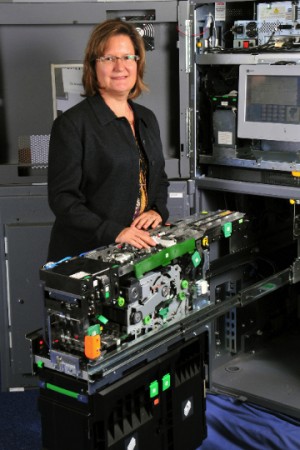
Cashing In
By Treena Hein
General design engineeringNew Canadian technology makes ATM line-ups a whole lot faster.

NCR Canada’s Director of Engineering Susan Carreon displays her team’s Scaleable Deposit Module, an ATM that accepts bills and checks for deposit simultaneously.
However, when a person has to deposit a bunch of items at once at the ATM, it can take quite a while. That’s why a team at NCR Canada in Waterloo Ontario, headed by Director of Engineering Susan Carreon, has developed a new ATM that allows consumers to rapidly deposit an assortment of up to 50 banknotes and cheques all at once, no envelopes needed. It’s been welcomed by U.S. banks and will be arriving in Canada soon (after enabling legislation is passed).
When dollar bills and cheques are fed in, the NCR ‘Scaleable Deposit Module’ separates each item, straightens it so the best image can be taken, and then passes it through camera and sensor arrays.
“If it’s a banknote, the technology determines the denomination and checks security features,” says Carreon. “If it’s a cheque, the machine ‘reads’ the magnetic codeline at the bottom and the handwritten amount.”
The system then displays cheque images, along with a summary of the cash deposit and total deposit for the consumer to confirm. This same information, including thumbnail images of cheques, is provided on the receipt. The whole process for an average deposit takes under 60 seconds.
The NCR scanning system is a two-sided full colour image scanner with specialised magnetic, transmissive and invisible spectrum sensors for currency and cheque validation. Errors occasionally can happen, but they’re prevented in several ways.
“The first is the ability of the consumer to review and correct the deposit on the screen,” notes Carreon. “If the handwriting is too messy, the system will display the image of the cheque and prompt the consumer for the amount.”
If the bills or cheques are in very poor condition, the system will return them. “Occasionally, the system can jam on damaged items, and in that case, the ATM will automatically send for service help,” adds Carreon. The other failsafe is in the bank’s final processing, where cheques and currency are cleared and any discrepancies picked up on.
Carreon says that although they’ve been working on cheque processing technology at NCR Waterloo for almost 40 years, it’s only been in the last seven years that the technology has been inexpensive and reliable enough to be able to adapt it to an ATM. Among the many challenges involved, two stand out.
“How to create a system that physically handles cheques is something we had a lot of experience with, but building one that can handle cheques and banknotes intermixed was tricky,” she says. “Cheques are made of stiff paper, and dog-ears and creases are common, so the transport mechanisms have to be able to overcome that. Dollar bills, especially older ones, can be very soft, and that requires different handling. We had to devise mechanisms that could manage both.”
The second challenge was quick recognition. “There’s a lot of processing that has to go on in a very short span of time to gather and process all the images and sensor data from the note or cheque, be able to decide which it is, denominate and validate the notes and read the amounts on the cheques – and then move the items to the correct location inside the machine,” Carreon says.
“If the transaction time took a lot longer than the current envelope deposit system, there wouldn’t be any point. It was one thing to get quick processing in place, but the technology also had to be inexpensive and reliable enough.”
Overcoming these challenges requires a highly multi-disciplinary team, which Carreon loves leading. “The mechanics, electronics, firmware and software required to make this system work are tightly interconnected and we’re constantly discovering new ways to make the system better,” she says.
She also thinks it’s fascinating to see new types of currency and different features and to stay on top of ways to process them. “We have so many ideas on how to make the SDM faster, more reliable, cost-effective and globally-applicable,” she says. “I don’t think we’ll ever stop innovating.”
www.ncr.com
